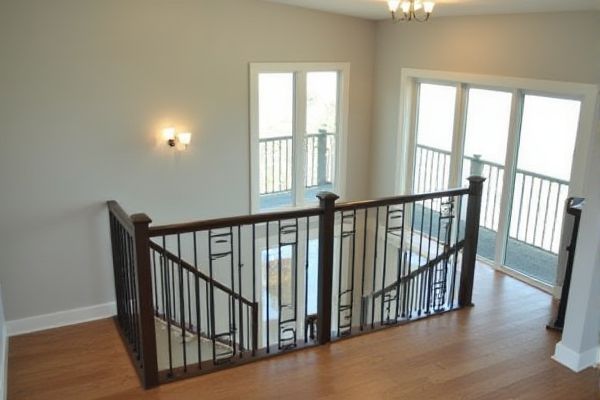
Glass infill offers a sleek, modern aesthetic with unobstructed views and requires minimal maintenance, while metal infill provides greater durability and a variety of design options with enhanced security. Discover which railing infill best suits your style and functional needs by exploring the detailed comparison in the rest of this article.
Table of Comparison
| Feature | Glass Infill | Metal Infill |
|---|---|---|
| Material | Tempered or laminated glass panels | Steel, aluminum, or wrought iron |
| Appearance | Modern, transparent, sleek | Traditional to industrial, opaque |
| Durability | Strong, scratch-resistant, may chip | Highly durable, rust-resistant with treatment |
| Maintenance | Regular cleaning to prevent smudges | Periodic painting or rust prevention |
| Safety | Tempered glass is shatter-resistant | Sturdy, impact-resistant |
| Cost | Higher initial cost | Generally lower cost |
| Installation | Requires precise fitting and sealing | Easier and faster to install |
| Privacy | Transparent or frosted options | Opaque, customizable patterns |
| Weather Resistance | Resistant to wind and water; avoid scratches | Good resistance, may need coating against corrosion |
Introduction to Railing Infill Options
Glass infill for railings provides a modern aesthetic while offering unobstructed views and safety, ideal for both residential and commercial spaces. Metal infill, available in materials like stainless steel or wrought iron, delivers durability and strength with various design possibilities suited to traditional or industrial styles. Choosing between glass and metal infills depends on factors such as maintenance requirements, visual preference, and environmental exposure.
Overview of Glass Infill for Railings
Glass infill for railings provides a sleek, modern aesthetic while offering unobstructed views and allowing natural light to flow through spaces. This option uses tempered or laminated safety glass panels that are durable, low maintenance, and resistant to weather and corrosion. Your choice of glass infill enhances both the visual appeal and functionality of railings, making it ideal for homes and commercial properties seeking a contemporary, open feel.
Overview of Metal Infill for Railings
Metal infill for railings offers exceptional strength and durability, making it ideal for both residential and commercial applications where security and longevity are priorities. Common metal materials include stainless steel, aluminum, and wrought iron, each providing resistance to corrosion and low maintenance requirements. You can customize metal infill with various designs such as cables, bars, or panels to match aesthetic preferences while ensuring structural integrity.
Aesthetic Appeal: Glass vs Metal Infill
Glass infill for railings offers a sleek, modern aesthetic that enhances visibility and creates an open, airy feel, making spaces appear larger and more inviting. Metal infill provides a more traditional or industrial look with intricate designs and a durable finish, adding texture and a sense of solidity to the structure. Choosing between glass and metal infill depends on the desired visual impact, with glass favoring transparency and minimalism, while metal emphasizes strength and decorative detail.
Durability and Maintenance Comparison
Glass infill for railings offers excellent corrosion resistance and requires minimal maintenance beyond regular cleaning to maintain clarity and prevent staining. Metal infill, while generally more durable under heavy impact, may be prone to rust or corrosion depending on the material and finish, necessitating periodic inspections and protective coatings. Your choice between glass and metal infill should consider the trade-off between easy upkeep and long-term structural resilience.
Safety Considerations for Glass and Metal Infill
Glass infill for railings offers excellent visibility and modern aesthetics but requires tempered or laminated safety glass to prevent breakage risks and ensure impact resistance. Metal infill, typically made from stainless steel or wrought iron, provides superior strength and durability, minimizing the risk of bending or breaking under pressure. Both materials must meet relevant building codes for load-bearing capacity and height requirements to guarantee safe use in residential and commercial settings.
Cost Analysis: Glass Infill vs Metal Infill
Glass infill for railings typically involves higher initial costs due to material expenses and specialized installation requirements, averaging $45 to $100 per linear foot. Metal infill, including options like stainless steel or wrought iron, generally offers a more cost-effective solution, with prices ranging from $20 to $75 per linear foot depending on the metal type and design complexity. Long-term maintenance costs favor glass, as it resists corrosion and requires less upkeep compared to metal, which may need periodic painting or rust treatment.
Installation Process and Complexity
Glass infill installation for railings involves precise measurements, specialized glazing techniques, and careful handling to prevent damage, making the process more complex and time-consuming than metal infill. Metal infill, typically using pre-fabricated balusters or panels, offers a straightforward installation with standard fasteners and fewer risks of breakage, resulting in faster assembly. The complexity in glass infill rises from securing tempered or laminated glass panels safely within the frame, requiring skilled labor and specific hardware to meet safety codes.
Best Applications for Each Infill Type
Glass infill panels are ideal for railings in modern residential or commercial settings where unobstructed views and natural light enhancement are priorities, such as balconies, pool areas, and staircases. Metal infill, including options like wrought iron or stainless steel, provides superior strength and security, making it suitable for industrial, outdoor, or high-traffic environments requiring durability and low maintenance. Your choice depends on aesthetic goals and functional needs, balancing transparency with robustness.
Making the Right Choice for Your Railings
Choosing between glass infill and metal infill for railings depends on factors such as aesthetic appeal, maintenance requirements, and safety considerations. Glass infill offers a modern, transparent look that maximizes visibility and light, while metal infill provides durability and a traditional or industrial style with lower upkeep. Evaluate your design preferences, environmental exposure, and budget to make the most informed decision for your railing project.
 homyna.com
homyna.com